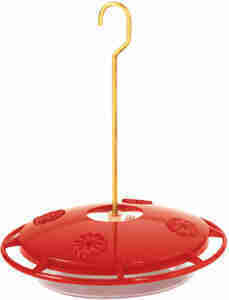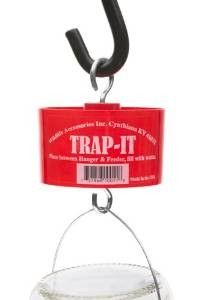Attracting hummingbirds to your garden can be a delightful experience, but dealing with leaky feeders can quickly turn it into a frustrating ordeal. In this guide, we’ll explore the world of non-leaking hummingbird feeders, helping you choose the best options to keep your tiny visitors happy and your outdoor space clean. From understanding the different types of leak-proof designs to mastering proper maintenance techniques, we’ve got you covered with expert tips and recommendations.Use only non-leaking hummingbird feeders to increase your hummingbird enjoyment.
Understanding the Importance of Non-Leaking Hummingbird Feeders
Why Leaky Feeders Are a Problem
Leaky hummingbird feeders are more than just a nuisance; they can cause several issues:
-
Wasted nectar and increased costs: When feeders leak, you’re essentially pouring money down the drain.
-
Attraction of unwanted insects: Spilled nectar can attract ants, bees, and wasps, which may deter hummingbirds.
-
Potential harm to hummingbirds: Leaking nectar can ferment or grow mold, potentially making hummingbirds sick.
-
Mess and damage to outdoor surfaces: Sticky nectar can stain patios, decks, and other surfaces.
Benefits of Non-Leaking Feeders
Investing in a non-leaking hummingbird feeder offers numerous advantages:
-
Improved hygiene for hummingbirds: Clean, fresh nectar is always available.
-
Reduced maintenance and cleaning time: Less mess means less work for you.
-
Cost-effective in the long run: You’ll save money on nectar and cleaning supplies.
The nectar will also attract bees, ants and wasps
But the nectar in the feeder that attracts the hummingbirds will also attract bees, ants and wasps, which can keep your hummingbirds from using the feeder at all.
This is where non-leaking hummingbird feeders can be very helpful to keep away uninvited guests. Non-leaking hummingbird feeders will prevent the nectar from leaking out of the feeding ports onto the outside of the feeder and onto the ground where it will attract all kinds of unwanted visitors.
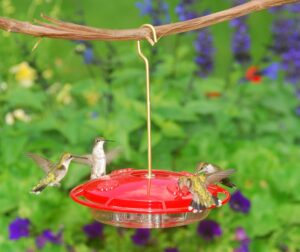
Two types of hummingbird feeders
For the most part, hummingbird feeders are divided into two types, basin (saucer feeders) and inverted bottle feeders.
A saucer feeder is a little dish with a cover on top and little holes in the top of the saucer where the hummingbirds can lap the nectar out through the top.
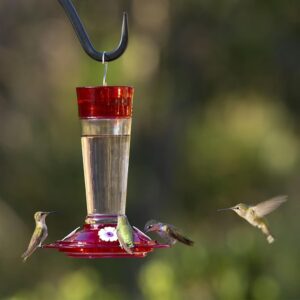
The inverted bottle style feeders will have a bottle-like container that will screw into the base of the feeder. The problem with the inverted bottle style feeder is that in hot weather they will leak. The airspace created when the nectar level goes down, heats and expands, which pushes nectar out of the feeding ports and onto the outside of the feeder, where it can attract bees, ants and wasps.
In the saucer feeders the nectar level is below the feeding ports and won’t expand to drive nectar out of the feeder. Saucer feeders are leak proof.
Worlds best hummingbird feeder
What kind of hummingbird feeder is the worlds best hummingbird feeder?
The best choice then, to have a non leaking hummingbird feeder, is the saucer hummingbird feeder. There are a lot of different styles of this type of feeder to choose from. So, to pick the best hummingbird feeder, I have listed some of the top features to look for.
How to choose the best non-leaking hummingbird feeder:
red color-Hummingbird are attracted to red, so pick a feeder that is red, then you won’t have to use red dye in the nectar to attract hummingbirds.
ant protection-Hummingbird feeder with ant moat, built in ant moat, or add-on ant moats will keep ants out of your feeder.
bee guards- The yellow color of most bee guards is the most attractive color to bees and wasps. So don’t use yellow. Some of the newer feeders are designed to keep out bees and wasps without using the yellow bee guards.
built in perches.A perch will allow your hummingbirds to sit still while feeding to give you a better look and to conserve their energy while they feed.
easy to clean. You want a feeder that you can take apart to access internal parts of the feeder so you can keep it clean. A clean feeder is very important if you want to attract hummingbirds and it’s important to their health.
Here is the ultimate guide on how to clean a hummingbird feeder.
rain guard -Some hummingbird feeders with their feeding ports located on top of the basin may allow rain to run into the feeder and dilute the nectar
So, to find the best hummingbird feeder, all you have to do is find non-leaking hummingbird feeders that have all of these important features.
Well don’t worry, because I have done all the work and found one for you! Below is one of the best non-leaking hummingbird feeders, that has all the right features.
Worlds best hummingbird feeder (hummingbird feeder with ant moat)
My choice for worlds best hummingbird feeder, one which is easy to take apart and clean, is one of the non-leaking hummingbird feeders and is a hummingbird feeder with an ant moat, is the Hummzinger Ultra.
Aspects 12oz Hummzinger Ultra With Nectar Guard
It has patented Nectar guard tips which are flexible membranes attached to the underside of the feed ports that keep flying insects like bees ans wasp for reaching the nectar, but allow Hummingbirds to feed as usual. The Hummzinger also has a built in ant moat that will stop crawling insects from getting to the nectar. If ants get into the nectar they will drown and their decomposing bodies will ruin the nectar, It also has raised flower ports that keep out rain water.
This mid-size nectar feeder has a 12 oz. capacity and can be hung or post mounted with hardware provided. It has four feeding ports for hummingbirds and is made of unbreakable polycarbonate.
Easy to clean. It will come apart in the middle giving you full access to the inside and no hidden surfaces that will be hard to clean. Easy to take apart and easy to clean means a lot of work saved for you. And it means the hummingbirds will have fresh nectar because you’ll be more like to keep it clean EVERYBODY WINS!!!
This would be my first choice in feeders. For ease of cleaning and protection from bees, wasps and ants, this feeder can’t be beat. The Hummzinger Ultra can solve all of your feeder problems at the same time.
Hummzinger hummingbird feeder video
Here’s a video of a Hummzinger feeder. Notice at about the 2:35 mark in the video, a bee checks out the feeding ports and can’t get in so the bee leaves. You can also see the built-in ant moat around the hanger, that keeps out ants. And notice the red, raised rain guards around the feeding ports that keep rain water from diluting the nectar.
Every feeder needs nectar, so here’s how to make your own. It’s easy, cheap and more healthy for the hummingbirds.
Hummingbird food recipe
*In a sauce pan mix 1 part sugar with 4 parts water and stir to dissolve the sugar as the food mixture comes to a boil.
*Boil 2 minutes, then remove from the heat.
*Once the nectar mixture is cooled you can fill the feeder
Use only water and white granulated table sugar. The same sugar you put on your cereal each morning. Don’t use any other kinds of sugar or sweeteners. Don’t use red food coloring. It may be harmful to the hummingbirds and it isn’t necessary. A red feeder is all that’s needed to attract hummingbirds.
Boil the water for 2 minutes. Boiling any longer will boil away too much water and make the nectar sweeter. Sweeter nectar is more attractive to bees and wasps. This 1 to 4 ratio of sugar to water matches the nectar found in the flower blossoms that hummingbirds feed on. So we don’t want to alter that ratio with prolonged boiling. Boiling the water also releases chlorine from the water and kills any mold spores or bacteria that might be in the sugar. This will make the nectar last longer in the feeder.
Here’s a video to demonstrate making hummingbird food.
Most people boil the nectar for 2 minutes. That’s longer than in the video.
How to make sure the nectar is always fresh
Fresh nectar is a must to keep hummingbirds at your feeder. They won’t come to a feeder that has spoiled nectar and spoiled nectar is bad for the health of the hummingbirds. With a few simple guidelines and by observing your nectar you shouldn’t have many problems.
The temperature of the outside air will determine how long your nectar will stay fresh. Heat will eventually cause the sugar in the nectar to ferment. The hotter the temperature outside, the quicker the nectar will ferment and have to be changed. Here is a chart that will give you a general idea as to how long your nectar will stay fresh without having to be changed. As you can see, as long as the temperature is in the 60’s your nectar should last about a week. As it rises the nectar will have to be changed more frequently.
Temperature/changing nectar chart
High temperatures…………Change nectar after
71-75……………………………6 days
76-80……………………………5 days
81-84……………………………4 days
85-88……………………………3 days
89-92……………………………2 days
93+………………………………change daily
The chart will give you a general idea. But, a visual inspection of the nectar in your feeder will tell you when to change it. If the nectar starts to look cloudy it needs to be changed and replaced with fresh nectar. It’s much better to change the hummingbird nectar sooner than, than later. If you wait too long the nectar will look cloudy and you will see black specks of mold in the nectar. You may also see mold growing on your feeder. The nectar will contain mold and bacteria that is harmful to hummingbirds. The mold will also make cleaning your feeder a lot harder.
How to clean a hummingbird feeder
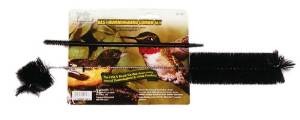
Change the nectar before it gets cloudy and moldy and all you have to do is rinse your feeder out with hot water before you fill it with fresh nectar. The National Audubon Society says to clean a feeder once a week by rinsing it out with a solution of 1 part white vinegar to 4 parts water. After rinsing with the vinegar solution, rinse your feeder out 3 times with clear warm water before refilling with fresh hummingbird sugar solution.
If for some reason you don’t change the nectar soon enough you will find mold inside the feeder. Then you will have to clean the feeder with a mild bleach solution to kill the mold and to sterilize the feeder. To make the cleaning solution add 1/4 cup bleach to 1 gallon of water. Soak the entire feeder in this solution for an hour. When the hour is up, take the feeder out and rinse it thoroughly, several times under running water. If there is any mold left on the feeder when you take it out you can scrub it off with some hummingbird feeder brushes.
If you have a feeder that’s easy to take apart and easy to clean, which means you have easy access to all the internal part, it will save you a lot of effort.
Make sure all the bleach has been removed so the bleach doesn’t harm the hummingbirds. Whether you discover mold in your feeder or not, you should your feeder in this mild bleach solution about once a month. That will insure that your feeder stays clean and will be attracting hummingbirds.
Here is a helpful video on cleaning a hummingbird feeder
You’ll see how to clean a feeder and you’ll see some of the brushes available to assist you in removing mold.
Keeping bees, ants, wasps and other insects off of your hummingbird feeder
If you have one of the Hummzinger feeders, ants, bees and wasps won’t be a problem. If you don’t have a Hummzinger, here are a few things you can do to prevent insects from bothering your feeder.
Ant moat for a hummingbird feeder
The best way to keep ants off your feeder is to add an ant moat. An ant moat is a container that holds water and keeps ants from reaching the nectar. The ants can’t swim, so your nectar is safe. Otherwise, ants will get into the nectar, drown and ruin it.
The ant moat or ant barrier as they are sometimes called, fits between the feeder and the feeder hanger that hangs the feeder. Moats can be found that are made out of different materials such as plastic, ceramic and metal. Some are quite decorative and add a nice look to your feeding station.
You might want to try your hand at making your own ant moat. Below is a video about how to make an ant moat.
How to keep bees and wasps off a hummingbird feeder
Keeping bees and wasps off of your hummingbird feeder is easy if you have the Hummzinger, if not, it will be a lot more challenging. I have had bees and wasps so thick at my feeder that the hummingbirds couldn’t even feed.
*One method people use is to move the feeder a few feet away and hope the bees don’t find it. I guess bees aren’t too smart and may quickly give it looking for the feeder if it’s moved. Of course, the hummingbirds will soon find it again.
*Others will simply take the feeder down for a few days until they are sure the bees have left the area. Once the feeder is back up the hummingbirds soon find it again.
*Some people put up a feeder just for the bees and wasps. They will use a 1 to 3 recipe instead of a 1 to 4. That makes the nectar sweeter so that the bees will go to it and leave the hummingbird feeder alone.
*Some feeders come with the yellow bee guards on the feeding ports, but yellow is a color that attracts bees and kind of undermines the situation.
I recently have discovered a video where a guy bee proofs his feeder using the plastic mesh from an onion sack. That video is below.
How to bee proof a hummingbird feeder
Frequently Asked Questions
How often should I clean my non-leaking hummingbird feeder?
Clean your feeder every 3-5 days, or more frequently in hot weather, to prevent mold growth and ensure the nectar remains fresh for hummingbirds.
Can I use honey or artificial sweeteners in my hummingbird feeder?
No, stick to plain white sugar dissolved in water. Honey can promote harmful bacterial growth, and artificial sweeteners lack the necessary calories for hummingbirds.
How can I keep ants away from my non-leaking hummingbird feeder?
Use feeders with built-in ant moats or install separate ant guards. Avoid using pesticides or oils that could harm hummingbirds.
What’s the best color for attracting hummingbirds to my feeder?
Red is the most attractive color for hummingbirds. Many non-leaking feeders feature red components to help attract these tiny birds.
Conclusion
Now you know all about non-leaking hummingbird feeders. You know how to make hummingbird food and when to change the nectar in the feeder. You know how to clean a feeder and you know how to keep bees and ants off your hummingbird feeder.
With all this knowledge you should be able to get the most possible enjoyment out of your hummingbirds!
If you found this article helpful please share it using the social bookmarking buttons on the left side of this page. Help everyone to increase their enjoyment of hummingbirds. Do it for the hummingbirds!
Hummingbird Resources
U.S. Fish and Wildlife Service – Hummingbird Conservation
This site offers detailed information about various hummingbird species, their habitats, and conservation efforts. It also provides resources on how to protect these fascinating birds.
National Park Service – Hummingbird Resources
The National Park Service offers insights into hummingbird species found in national parks, their behaviors, and their role in ecosystems, along with tips for observing them.
Smithsonian National Museum of Natural History – Birds: Hummingbirds
This resource provides educational materials on the role of hummingbirds in pollination and biodiversity, backed by scientific research and exhibits from the Smithsonian.
U.S. Geological Survey – Hummingbird Studies
The USGS offers research on hummingbird migration patterns, population dynamics, and environmental threats, including studies on climate change impacts.
The Cornell Lab of Ornithology – Hummingbirds
While not strictly a government site, Cornell partners with federal agencies to provide valuable scientific insights into hummingbird behavior, conservation, and field guides.
